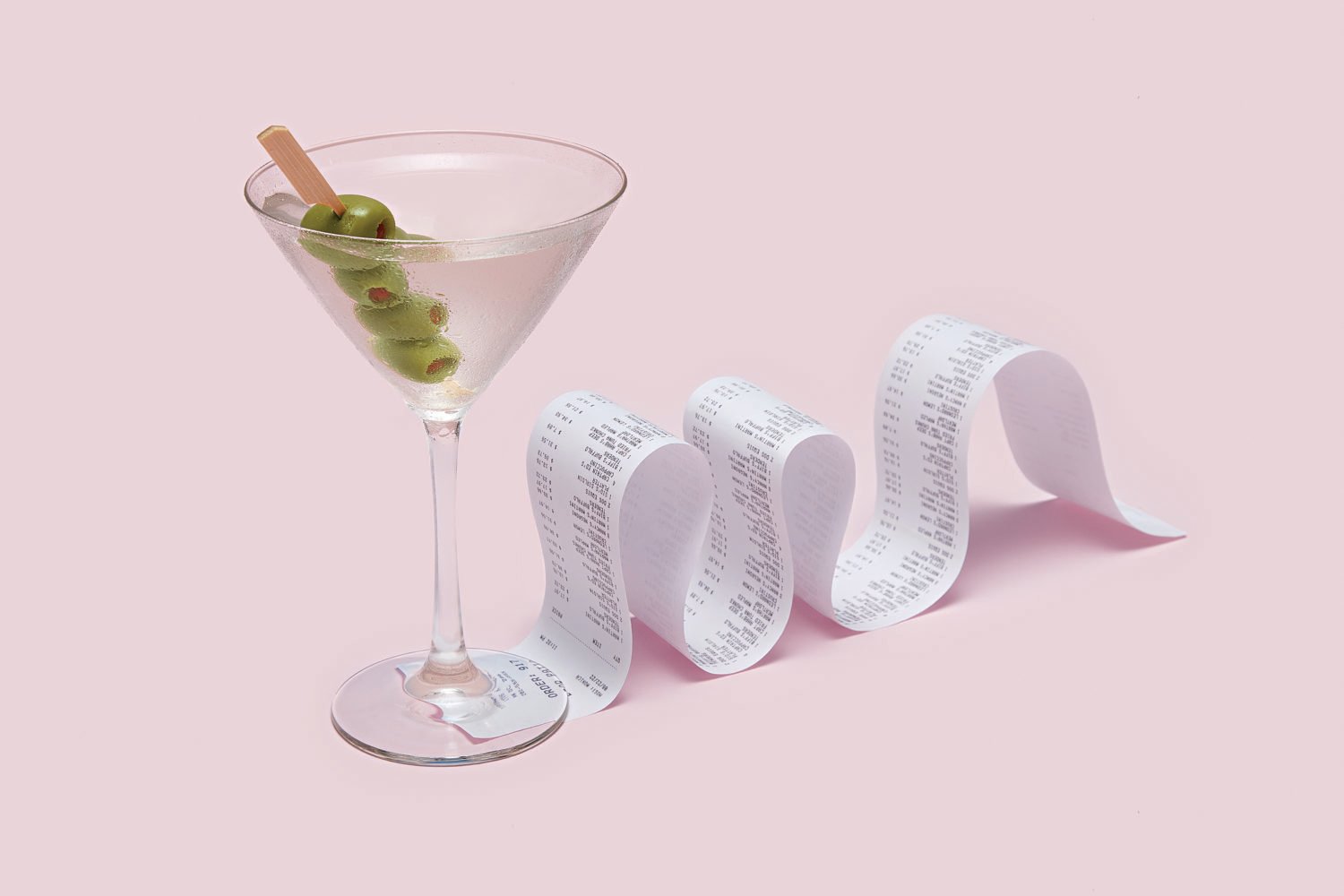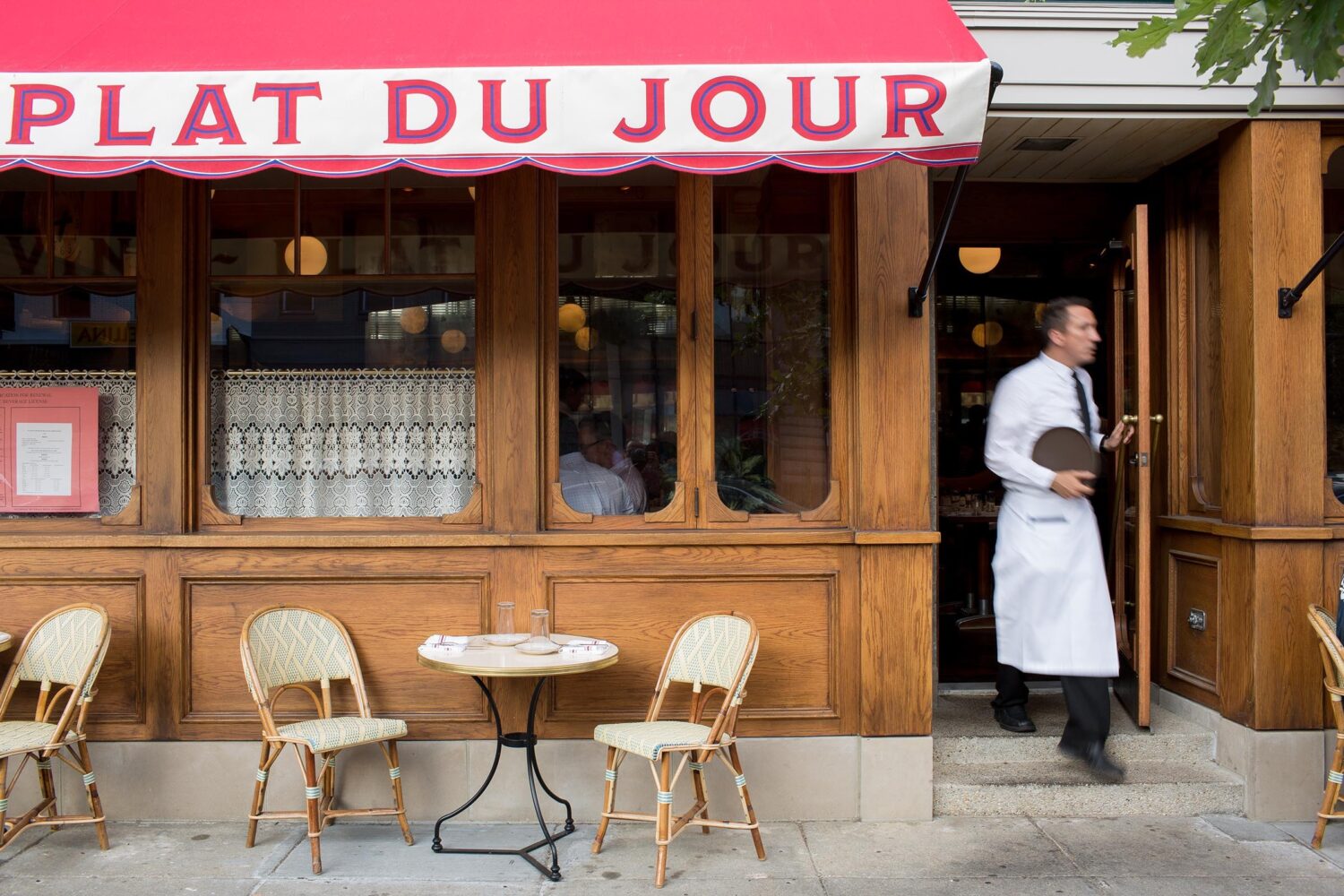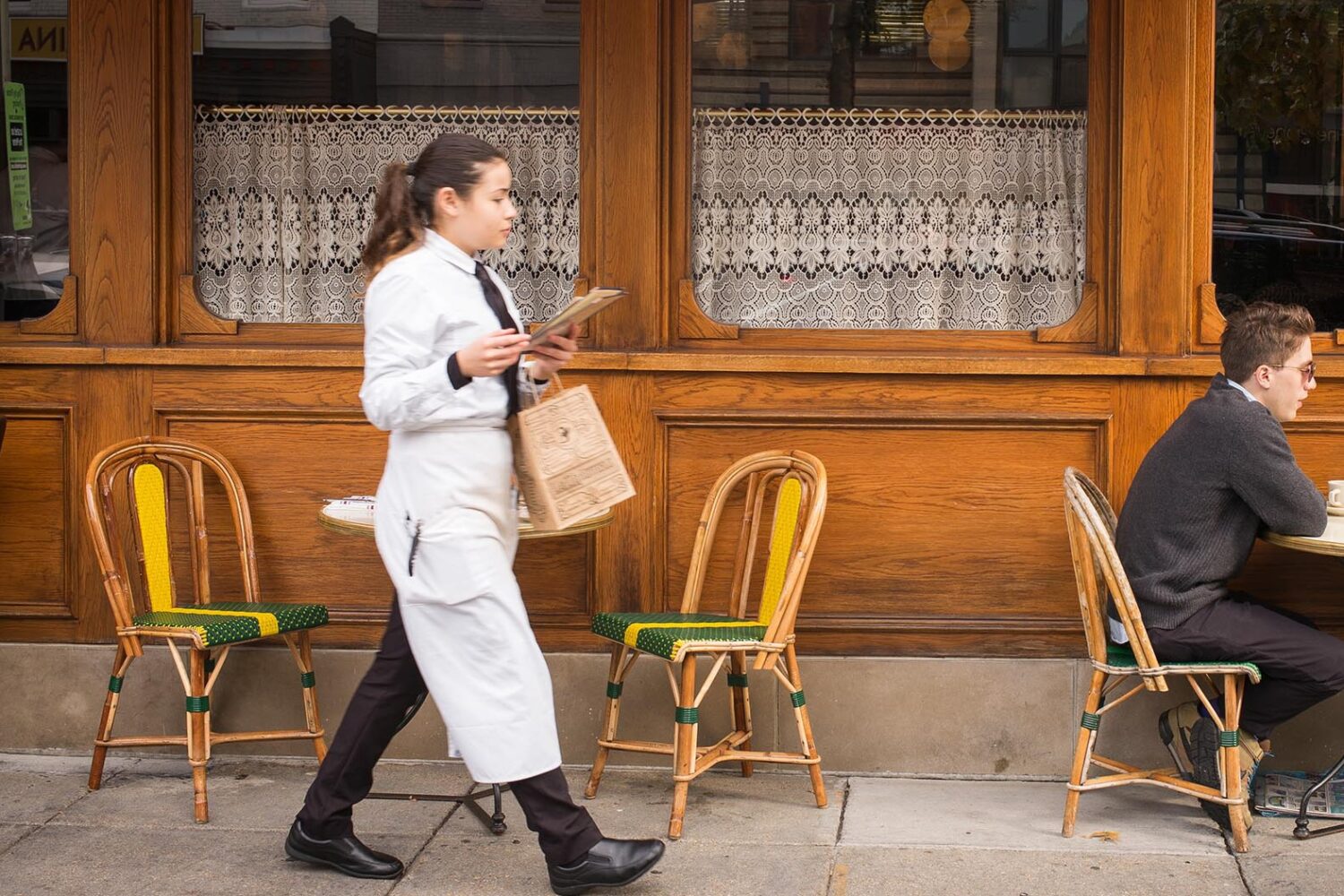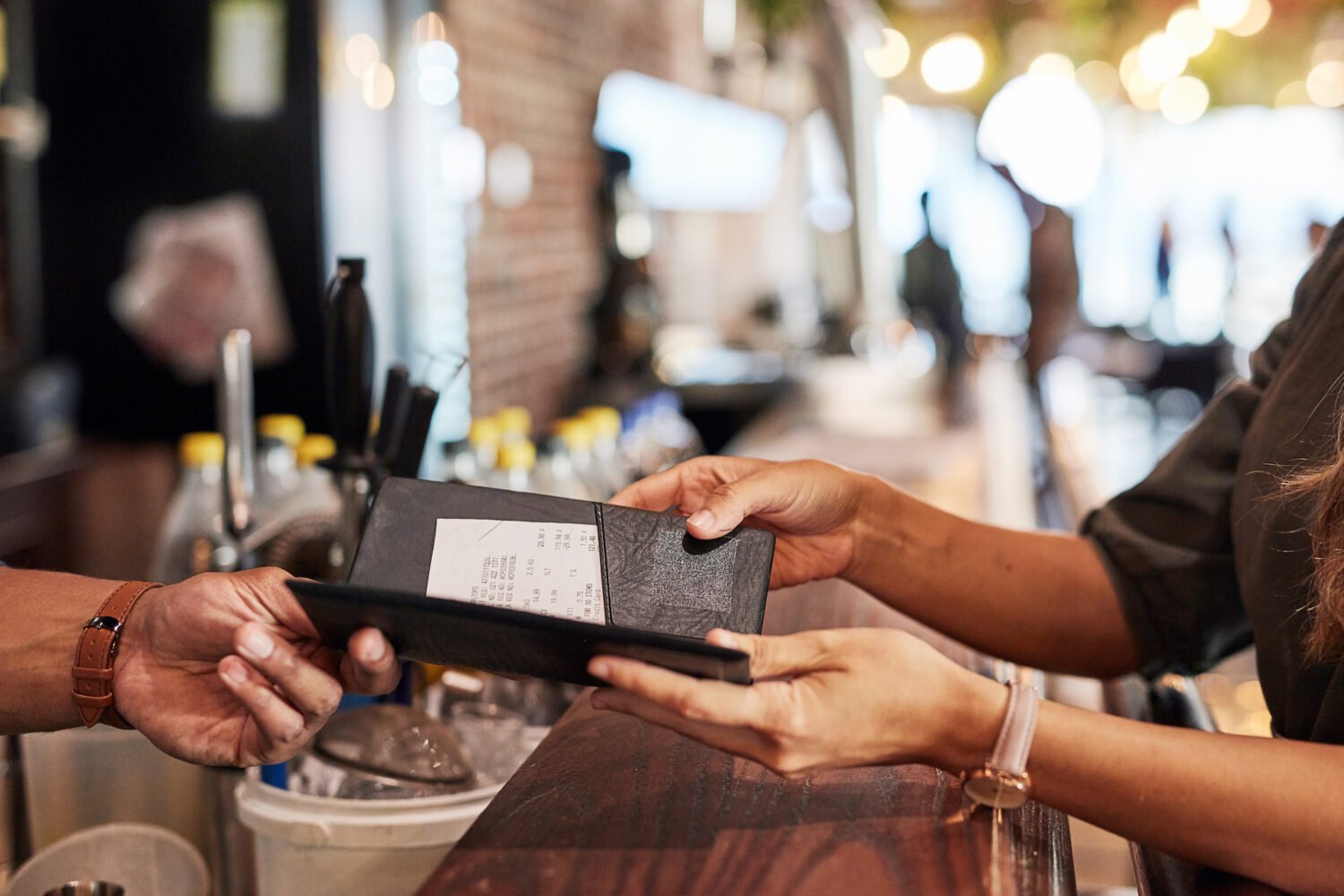Christine Lilyea was a folk-rock singer and music-venue manager, so opening her own 1970s-inspired live-music and burger bar was a dream come true. And the first year of the Runaway in DC’s Brookland neighborhood rocked, with plenty of buzz and packed crowds. But by the summer of 2023, business was tumbling. Lilyea struggled to find the right staff, which meant service was suffering and she was losing customers. Meanwhile, her labor costs were rising, thanks to a new DC law phasing out the traditional “tip credit” system that allows customers’ gratuities to pay for the bulk of wages.
So last November, Lilyea grudgingly announced an 8-percent service charge to offset the wage increases, following the lead of a growing number of restaurants and bars. “This charge is not a gratuity and does not go directly to your server,” she wrote on Instagram. “Please continue to tip them accordingly for their service, and thank you.”
Backlash was swift. Her comment section was filled with people telling her it was a terrible idea. Lilyea says someone even left a one-star Google review complaining about the fee—never mind that she had yet to implement it. Hours later, she reversed course: “Ok ok we will just raise prices. Thanks love you.”
But Lilyea couldn’t bring herself to just raise prices. “People say that, but they don’t want that either,” she says. Instead, Lilyea scaled back the burger menu and staff hours. “The more I scaled back, the more I was like, ‘I don’t really want to do this anymore. I’m starting to not care,’ ” she says. “It’s taken the heart out of everything.” In January, Lilyea announced that the Runaway was closing. “It felt pointless, everything I’d done,” she says.
Then a small miracle happened: Lilyea’s landlord told her he would reduce her rent. Lilyea cried happy tears. “We’re not out of the dark yet, but now we have a fighting chance,” she says, knowing her labor costs will continue to rise as the tip-credit system is fully eliminated over the next three years. To manage that transition, Lilyea is thinking of ways to bring in more bands and focusing on selling alcohol rather than food. She’s not considering fees. “I don’t see me ever doing it,” she says. “Unless everybody understands it, I can’t. I don’t want to be the teacher. And I don’t want my staff to be yelled at.”
Changing the Rules
The traditional model of how you pay at a restaurant—and, in turn, how restaurant workers get paid—has always been a complicated game, but pretty much everyone understood the rules. You ate your burger, you tipped about 20 percent, and that money went to the people serving you. As of a couple years ago, the restaurant could pay your server as little as $5.35 an hour, but your gratuity would help bring them up to DC’s $17 minimum wage. If tips fell short, the business had to make up the difference. Or maybe that was never an issue, because tips were allowing your server to earn $30, $40, or more per hour.
That entire system was toppled by Initiative 82, the ballot measure that District voters overwhelmingly passed in 2022. Over the last year, the law has increased the tipped minimum wage to $8 an hour. It will go up to $10 in July and continue to rise incrementally until it reaches the full minimum wage in 2027. Advocates for the law argue this shift will create more stability for workers and make their livelihoods less dependent on the whims and biases of strangers. But it also means costs coming out of the businesses’ pockets are going way up.
Enter service-fee mania. A way for restaurants to essentially raise prices without looking like they’re raising prices, surcharges are everywhere these days. Unfortunately, no one seems to know the rules of this new game. Restaurants might charge you a 3-percent fee, or 22 percent. You’re not totally sure how much of that goes to your server—and your server might not be sure, either. You no longer know how much to tip. Are you being stingy or are you being scammed? You suddenly wish you were better at math.
“The real sticker shock is thinking that you’re going to pay $10 for a sandwich and then, in the end, you realize, ‘Oh, no, there’s actually a fee.’”
Dining out is now a debate—and sometimes a debacle. Are the fees sneaky or transparent? Are the restaurants greedy or surviving? Fee fighters are ranting on Reddit, organizing political campaigns, and even filing lawsuits. Restaurateurs feel misunderstood and vilified. They’re experimenting with different ways of doing business that will pay staff and bills without pissing off customers. That little line at the bottom of your check is now a battleground, from the lowest pits of Yelp to the highest levels of government, and how the fight unfolds could substantially change both the industry and the way we eat out. In the meantime, can someone tell us how much this burger costs, really?
Back to Top
Fee Fighters
The complaints were stacking up, and DC attorney general Brian Schwalb had to do something. So last spring, his office released a consumer alert about restaurant fees. The main takeaway: Businesses must “clearly and prominently” disclose fees before customers place their orders, and they must accurately describe what the fee is for. No more ambiguous terms like “restaurant recovery” fee without explaining specifically what it will help recover.
In addition, anyone who encountered an allegedly deceptive fee was invited to submit a complaint via an online form. At least 200 such complaints, obtained by Washingtonian via a Freedom of Information Act request, were filed by December 2023, spanning every type of restaurant you can imagine, from fine dining to sports bars to coffee shops. The common denominator? A nagging sense that restaurants are trying to pull a fast one:
Service fee is hidden when you close out your tab.
No description as to what this fee is for or how the money is used.
They are lying and FORCING customers to pay fees.
It’s fraud, pure and simple.
“People are begging restaurants to just include [labor-cost increases] into their menu prices because that would be more sensible and more fair,” says Eduarda Serafim, coordinator for Fair Price Fair Wage, a coalition that has been campaigning against fees and whose membership includes many of the organizations that pushed for I-82 in the first place. “The real sticker shock is thinking that you’re going to pay $10 for a sandwich and then, in the end, you realize, ‘Oh, no, there’s actually a fee on it and I didn’t know about this before.’ ”
Schwalb’s office has yet to file a fee-related lawsuit against a restaurant, preferring to first educate owners on compliance. In the meantime, some diners are turning into fee vigilantes. The origin story for Sarah Stella, a federal-government employee, started at a ramen restaurant. She missed the 20-percent service fee ordering from a QR-code menu—and ended up paying 40 percent above the menu price.
“I like having the full information before I go out to eat,” she says. “Some people say, ‘Oh, I won’t go out if a place has a service fee.’ I don’t feel that way at all—I just want to know in advance.”
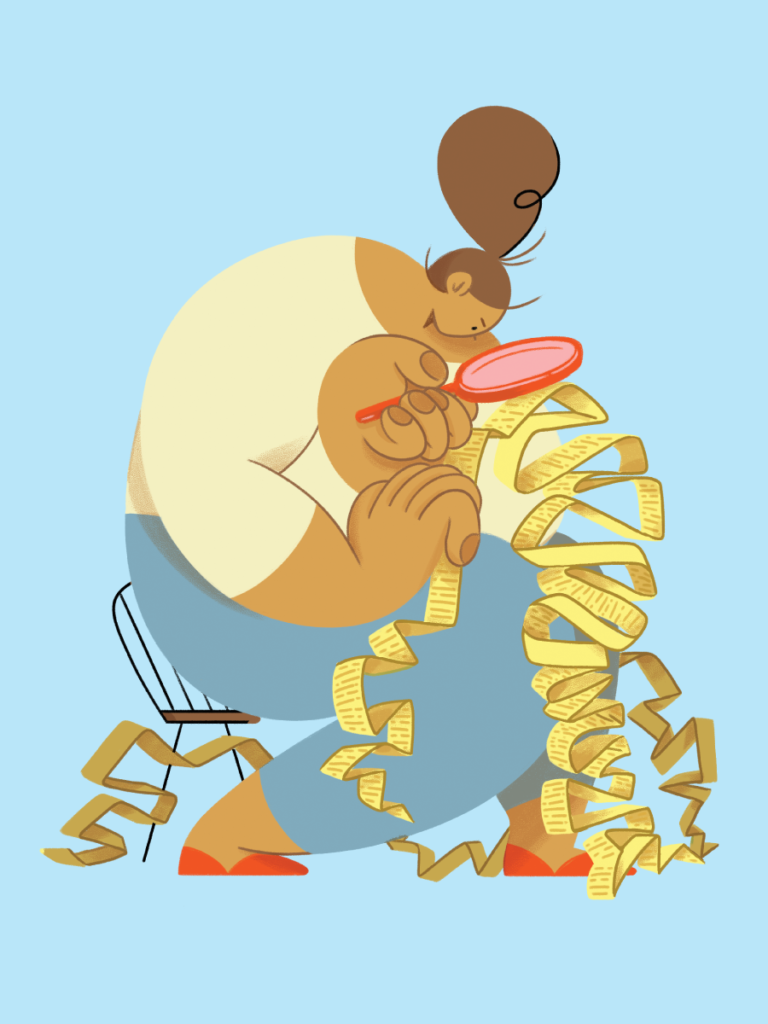
Seeing a slew of posts on Reddit about people being caught off-guard by menu surcharges, Stella created a fee-tracking spreadsheet and asked the public to help fill it in. Thanks to an avalanche of submissions, more than 260 restaurants are listed, with detailed information about their fees. Another Redditor even built a fee-tracking Chrome extension called TransparentFee DMV that creates a pop-up alert anytime users visit the website of a restaurant charging a fee.
Fair Price Fair Wage went a step further when it launched an Instagram page earlier this year rating restaurants: green for those with no fees, yellow for those with clear language about where the fee goes and whether it should replace a tip, and red for those with vague fee explanations. This immediately stirred up drama—and accusations of misinformation. The group rated the Cleveland Park Israeli spot Sababa “red” even though it no longer had a surcharge. “They should be sued if they’re putting out the wrong information,” says Sababa owner Ashok Bajaj. (FPFW later issued an updated green rating.) Meanwhile, the owners of the red-rated H Street ramen shop Toki Underground say their 18-percent service charge acts like an auto-gratuity, paying staff on top of their base wages, exactly the kind of add-on FPFW says it favors. But FPFW says that wasn’t clear from the original language on the restaurant’s website.
“This is a low-profit-margin business across the board,” says Toki Underground co-owner Jeff Jetton. “If we’re just willynilly shaming restaurants and boycotting them, this will affect a lot of businesses. [FPFW] better have their shit together or they’re going to cause a lot of damage to people who want to do the right thing.”
No part of the backlash has shaken the local restaurant industry more than a series of lawsuits targeting fees. Travelers United, a DC-based nonprofit advocating for travelers, has previously taken legal action against hotels and resorts for allegedly deceptive “junk fees.” Last November, the organization sued Clyde’s Restaurant Group for unfair and deceptive advertising because of its 3.75-percent “2023 surcharge.” A few months later, it took on Knead Hospitality + Design—the restaurant group behind Mi Vida, Succotash, Gatsby, and others—for its 3.5-percent “Initiative 82 fee.”
In both cases, Travelers United accused the restaurant groups of “drip pricing”—the advertising practice of promoting a lower price with hidden add-ons—which the organization argues violates DC’s consumer-protection laws. “It’s a fee for nothing,” says Travelers United counsel Lauren Wolfe. “This is simply a fee so that they can lie about the advertised price.” She also argues that the restaurants weren’t transparent enough about where the money was going.
Clyde’s and Knead shot back that their surcharges were, in fact, compliant with the DC attorney general’s guidelines. “I think it’s a little sad that they’re going after restaurants at a time when the forces of inflation and a lot of issues coming out of Covid are still really hanging on there,” Clyde’s Restaurant Group president John McDonnell says.
Ultimately, both restaurant groups dropped their fees, a move each claims to have been considering anyway. Travelers United subsequently dropped both suits but recently sued the group behind Proper 21 sports bars. The threat of litigation has spooked restaurant owners across the city: After Knead Hospitality was sued, Matt Hetrick—a CPA whose tax-and-accounting firm, Harmony Group, works with nearly 150 area restaurants—says he was bombarded with panicked calls.
“ ‘Are my labor increase fees compliant? Will I be sued? I can’t afford to defend myself—what should we do?’ ” Hetrick recalls hearing from owners. “They read that there are lawsuits and believe they have to rush off to switch their comp models to unsustainable structures or they’ll be sued into oblivion in the coming months.”
In March, the DC Council passed legislation aimed at protecting restaurants that clearly disclose fees from such private suits. However, Travelers United argues that nothing has changed. “It’s absurd to have industries think they can get exemptions from DC’s consumer-protection law,” Wolfe says. “We will continue to sue.”
Back to Top
Fraught Behind the Scenes
Here’s a little secret: The staunchest defenders of the fees—restaurant owners—kind of hate them, too. They’d rather not endure all the backlash. But facing a choice between raising menu prices and adding a new surcharge to the bottom of your check, they see the latter as the lesser evil, the best way to survive at a time when they’re tired of figuring out how to.
Why not “just” charge more for food and drink? Well, you’ve probably noticed that restaurants are already charging more, simply to keep up with the post-pandemic inflation that has made everything from beef to kitchen equipment more expensive. Plus, the only thing people love to complain about more than fees is a $25 burger or a $7 taco or a $16 cocktail.
Hetrick, the CPA, says restaurants are generally choosing between two types of fees. The first is a small fee—say, 3 or 4 percent—to offset their I-82–driven increase in labor costs. Customers are still expected to tip on top of that, same as they always have. “That one is the cleanest from the math perspective and from a legal perspective,” Hetrick says. It’s also the approach diners tend to hate most.
Other restaurants are adding fees of around 20 percent that are largely in lieu of tips (though customers can still give more if they want to). Unlike traditional tips that are legally required to go to service staff, the money from fees is considered business revenue, which means owners can disperse it however they want. Plenty of restaurants are now using some of that money for staff health benefits or to raise wages for kitchen employees, who traditionally make far less than front-of-house workers. These kinds of fees took off before I-82 as a way to fix the industry’s inequalities and uncertainties, especially during the pandemic, when wild fluctuations came with each new Covid variant and restriction.

Behind the scenes, however, a 20-percent fee can be fraught. Some restaurants are paying a flat hourly rate, which gives workers a predictable income but can potentially cap earnings that come with tips. Other restaurants treat at least part of the fees similarly to tips, paying “bonuses” on top of base wages. “There’s a lot of federal law that goes into actually complying with how you pay that stuff out,” Hetrick says. “It’s super-complicated, very difficult administratively to do it legally. Some restaurants are breaking the law accidentally.”
“I enjoy math, and I suppose I could make my own spreadsheet at home. But I don’t actually know the exact formula.”
Hetrick consulted with one DC restaurant after it was sued over wage violations for processing payroll as if the service fee were a tip. “They gave all the money to the staff,” Hetrick says. “It’s not like they held it back. They just processed it incorrectly. I believe the settlement for it might have cost them somewhere in the range of $75,000 to $100,000.”
As restaurants and customers alike wrestle with fees, it’s fair to ask: Is I-82 actually creating better pay conditions for workers? The answers, it turns out, are mixed and murky. Some employees say they’re making more. Others, less. A surprising number are totally confused about how much they’re actually making.
Server Ben Fersh has worked all over the place in the past year—a large restaurant with a traditional tipping system, a cocktail bar where he made a fixed amount every night, a cheffy spot with a 20-percent service charge that was divided among staff in a complex way. “You leave there on a given night not sure what you made whatsoever,” he says. “I enjoy math, and I suppose I could make my own spreadsheet at home. But I don’t actually know the exact formula, either. The chef didn’t know it off the top of his head when he was [initially] going over it with me.”
Bartender Nada Elbasha says it used to be fairly easy to calculate at the end of the night how much she made—but then the bars she works for switched to the 20-percent service-fee model. “It’s still a little bit unclear to me exactly how I get paid,” she says. “We’re just printing the report and sending it to the boss, and the boss is calculating it. I can look at the sales and look at my tips that are on top of the 20 percent and kind of do a general calculation in my mind. But it’s never completely accurate, because there’s so many other factors involved.”
While I-82 aimed to reduce the odds of wage theft, Elbasha says she left another job with a service fee partially because she was suspicious she wasn’t being paid properly. “We have less information and less power,” she says. “We’re just more vulnerable now at the hands of the business owners versus the customers.”
Restaurateur Hollis Silverman of Capitol Hill spots the Duck & the Peach, La Collina, and others pays staff $18 to $30 an hour using a 22-percent service charge, and any additional tips are split among the entire hourly team. She says she tries to make it very clear to employees how they get paid but that it can require a bit of a “reeducation” for servers and bartenders. “Some newer people come in and they’re like, ‘Why don’t I get to keep my tips?’ ” she says. “And it’s like, ‘Well, everybody contributes to the whole team.’ They get it, but it’s a little harder to change that mindset.”
“I thought tipping was a real stupid way to do things. I think service charges are slightly less stupid.”
From wage-theft lawyer Justin Zelikovitz’s perspective, I-82 has made things better for the most vulnerable restaurant workers—dishwashers, bussers, servers who double as cooks at mom-and-pop shops, often immigrants and people of color. Part of the difference now? Everyone’s scrutinizing pay. So yeah, some workers feel suspicious about their paychecks. But Zelikovitz has found that it also means more employers actually following the law. He’s starting to see less of the most egregious wage violations. “It’s rare these days that I see employers paying nothing, which I still do from time to time,” he says.
Zelikovitz finds the fees confusing, and he’d prefer that menu prices reflect the “correct” price. Still, in his mind, things have been worse. “There were a lot of shenanigans going on under the old regime,” he says. “I thought tipping was a real stupid way to do things. I think service charges are slightly less stupid.”
Back to Top
Back to the Future?
Are restaurant fees the future or a phase? Government intervention could make the entire discussion moot: The Biden administration has made it a priority to crack down on junk fees, and the Federal Trade Commission has proposed rules that would require businesses—including restaurants—to show their full prices upfront without charging hidden or misleading fees. New York already bans restaurant surcharges, and a similar law goes into effect in California this summer.
The battle is also playing out in the DC Council. March hearings aimed at providing relief for restaurants were consumed by confusion and chaos over how service fees should be used—or whether they should exist at all. The council rejected a proposal to speed up the rollout of I-82, which the Restaurant Association Metropolitan Washington argued would help businesses skip the current messy adjustment period and more quickly find a new normal. Ultimately, legislators didn’t directly tackle the fate of fees but did effectively cap them at 20 percent. A bigger showdown could be on the horizon.
In the absence of government regulation, fees could end up like espresso martinis—a hot trend that turns out to have staying power. Alternately, there’s a very real possibility everyone loses their taste for them and they largely go out of fashion. At Clyde’s restaurants, McDonnell believes higher prices will ultimately cover hourly pay, with tipping discouraged. “The reality is the really high-performing service people will make a lot less money than they used to,” he says, noting that some of his bartenders make $150,000 a year. “Maybe the lower-performing people will make more. What’s a fair average hourly rate? Someday in the District of Columbia, maybe all servers will be somewhere around $40 an hour, no tips. And that might seem good to people. It would be a huge pay cut for some of our people. But in the end, we’ll figure out the balance.”
That said, tipping is a habit we just can’t seem to quit. Many workers like the potential to earn more. Many customers like the sense of power and control. High-profile restaurateurs who have tried to ditch it, such as Danny Meyer in New York, have almost all relapsed. So perhaps after all the angst, the future looks a lot like the past—no fees, the option to tip—but with higher prices and base wages.
The entire cycle has already played out at Dacha Beer Garden. In early 2019, it became one of the first DC restaurants to add a service fee, before the pandemic and I-82. “We did it because we, as owners, believe it was the right thing to do, that all staff should be paid at least the full minimum wage even if they earn tips,” says co-owner Dmitri Chekaldin. The fees also helped workers get through Covid with healthcare benefits and bereavement leave.
But an early dispute over how the service charge was supposed to be divided among staff led a group of anonymous employees to accuse Dacha of wage theft—allegations Chekaldin has always denied. The complaints never escalated beyond news headlines to legal action, but they’ve been a cloud over the restaurant in the five years since. “We’ve experienced many, many angry comments,” Chekaldin says. “People give you bad reviews.”
Recently, Dacha dropped its “fair-wage fee.” The city’s backlash around fees was reaching a fever pitch, and in the confusion over who’s paying whom what, the owners felt customers couldn’t understand that they were paying their workers the full minimum wage while many businesses were not. “It’s losing its purpose,” Chekaldin says. “We found that it lumps us with those who double-dip.”
Appealing to diners who are fed up with fees, Dacha launched a “you asked, we listened” marketing campaign around the change. Because the restaurant had already spent five years trimming costs, improving operations, and gradually raising its prices, it didn’t need to suddenly charge a lot more. In fact, it actually lowered prices on some of its most popular beers.
“When the playing field is level for everybody, as it should be, then there should be no need for various service charges,” Chekaldin says. “The menu price will be the price, and that’s that.”
Tipping Pointers
How much should you tip on top of a service fee? While there’s no right answer for every circumstance, here are some general guidelines.
If the service fee is 20 percent (or more): The majority of restaurants don’t expect additional gratuity, and most diners don’t leave more. That said, if you want to recognize great food and service, an extra 5 to 10 percent is considered a nice gesture.
If the service fee is less than 20 percent: Unless otherwise stated, the most common approach is for the service fee and tip to add up to 20 percent above the bill total. For example, if there’s a 5-percent fee, at least 15 percent in gratuity is generally expected–but consider 20 percent or more for an excellent experience.
Christine Lilyea was a folk-rock singer and music-venue manager, so opening her own 1970s-inspired live-music and burger bar was a dream come true. And the first year of the Runaway in DC’s Brookland neighborhood rocked, with plenty of buzz and packed crowds. But by the summer of 2023, business was tumbling. Lilyea struggled to find the right staff, which meant service was suffering and she was losing customers. Meanwhile, her labor costs were rising, thanks to a new DC law phasing out the traditional “tip credit” system that allows customers’ gratuities to pay for the bulk of wages.
So last November, Lilyea grudgingly announced an 8-percent service charge to offset the wage increases, following the lead of a growing number of restaurants and bars. “This charge is not a gratuity and does not go directly to your server,” she wrote on Instagram. “Please continue to tip them accordingly for their service, and thank you.”
Backlash was swift. Her comment section was filled with people telling her it was a terrible idea. Lilyea says someone even left a one-star Google review complaining about the fee—never mind that she had yet to implement it. Hours later, she reversed course: “Ok ok we will just raise prices. Thanks love you.”
But Lilyea couldn’t bring herself to just raise prices. “People say that, but they don’t want that either,” she says. Instead, Lilyea scaled back the burger menu and staff hours. “The more I scaled back, the more I was like, ‘I don’t really want to do this anymore. I’m starting to not care,’ ” she says. “It’s taken the heart out of everything.” In January, Lilyea announced that the Runaway was closing. “It felt pointless, everything I’d done,” she says.
Then a small miracle happened: Lilyea’s landlord told her he would reduce her rent. Lilyea cried happy tears. “We’re not out of the dark yet, but now we have a fighting chance,” she says, knowing her labor costs will continue to rise as the tip-credit system is fully eliminated over the next three years. To manage that transition, Lilyea is thinking of ways to bring in more bands and focusing on selling alcohol rather than food. She’s not considering fees. “I don’t see me ever doing it,” she says. “Unless everybody understands it, I can’t. I don’t want to be the teacher. And I don’t want my staff to be yelled at.”
Back to Top
Changing the Rules
The traditional model of how you pay at a restaurant—and, in turn, how restaurant workers get paid—has always been a complicated game, but pretty much everyone understood the rules. You ate your burger, you tipped about 20 percent, and that money went to the people serving you. As of a couple years ago, the restaurant could pay your server as little as $5.35 an hour, but your gratuity would help bring them up to DC’s $17 minimum wage. If tips fell short, the business had to make up the difference. Or maybe that was never an issue, because tips were allowing your server to earn $30, $40, or more per hour.
That entire system was toppled by Initiative 82, the ballot measure that District voters overwhelmingly passed in 2022. Over the last year, the law has increased the tipped minimum wage to $8 an hour. It will go up to $10 in July and continue to rise incrementally until it reaches the full minimum wage in 2027. Advocates for the law argue this shift will create more stability for workers and make their livelihoods less dependent on the whims and biases of strangers. But it also means costs coming out of the businesses’ pockets are going way up.
Enter service-fee mania. A way for restaurants to essentially raise prices without looking like they’re raising prices, surcharges are everywhere these days. Unfortunately, no one seems to know the rules of this new game. Restaurants might charge you a 3-percent fee, or 22 percent. You’re not totally sure how much of that goes to your server—and your server might not be sure, either. You no longer know how much to tip. Are you being stingy or are you being scammed? You suddenly wish you were better at math.
“The real sticker shock is thinking that you’re going to pay $10 for a sandwich and then, in the end, you realize, ‘Oh, no, there’s actually a fee.’”
Dining out is now a debate—and sometimes a debacle. Are the fees sneaky or transparent? Are the restaurants greedy or surviving? Fee fighters are ranting on Reddit, organizing political campaigns, and even filing lawsuits. Restaurateurs feel misunderstood and vilified. They’re experimenting with different ways of doing business that will pay staff and bills without pissing off customers. That little line at the bottom of your check is now a battleground, from the lowest pits of Yelp to the highest levels of government, and how the fight unfolds could substantially change both the industry and the way we eat out. In the meantime, can someone tell us how much this burger costs, really?
Back to Top
Fee Fighters
The complaints were stacking up, and DC attorney general Brian Schwalb had to do something. So last spring, his office released a consumer alert about restaurant fees. The main takeaway: Businesses must “clearly and prominently” disclose fees before customers place their orders, and they must accurately describe what the fee is for. No more ambiguous terms like “restaurant recovery” fee without explaining specifically what it will help recover.
In addition, anyone who encountered an allegedly deceptive fee was invited to submit a complaint via an online form. At least 200 such complaints, obtained by Washingtonian via a Freedom of Information Act request, were filed by December 2023, spanning every type of restaurant you can imagine, from fine dining to sports bars to coffee shops. The common denominator? A nagging sense that restaurants are trying to pull a fast one:
Service fee is hidden when you close out your tab.
No description as to what this fee is for or how the money is used.
They are lying and FORCING customers to pay fees.
It’s fraud, pure and simple.
“People are begging restaurants to just include [labor-cost increases] into their menu prices because that would be more sensible and more fair,” says Eduarda Serafim, coordinator for Fair Price Fair Wage, a coalition that has been campaigning against fees and whose membership includes many of the organizations that pushed for I-82 in the first place. “The real sticker shock is thinking that you’re going to pay $10 for a sandwich and then, in the end, you realize, ‘Oh, no, there’s actually a fee on it and I didn’t know about this before.’ ”
Schwalb’s office has yet to file a fee-related lawsuit against a restaurant, preferring to first educate owners on compliance. In the meantime, some diners are turning into fee vigilantes. The origin story for Sarah Stella, a federal-government employee, started at a ramen restaurant. She missed the 20-percent service fee ordering from a QR-code menu—and ended up paying 40 percent above the menu price.
“I like having the full information before I go out to eat,” she says. “Some people say, ‘Oh, I won’t go out if a place has a service fee.’ I don’t feel that way at all—I just want to know in advance.”
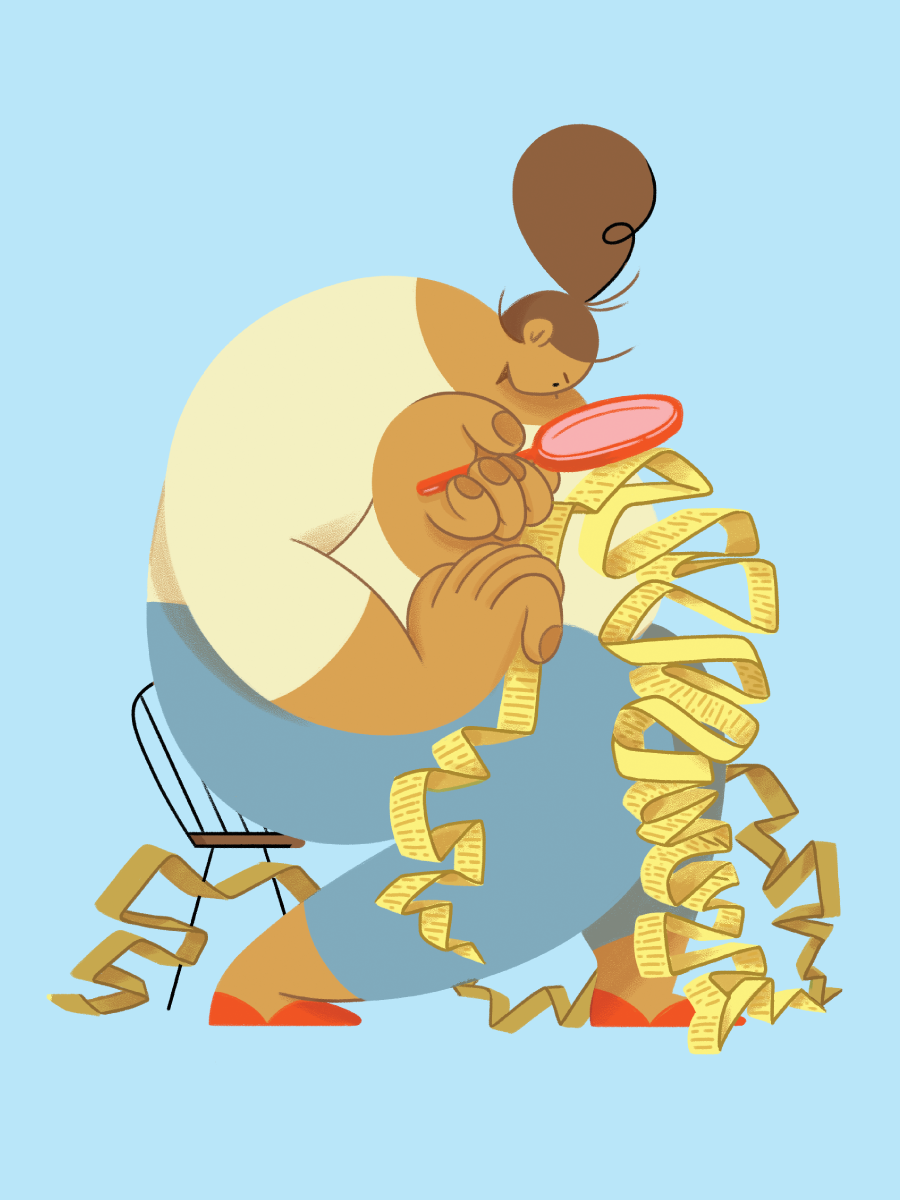
Seeing a slew of posts on Reddit about people being caught off-guard by menu surcharges, Stella created a fee-tracking spreadsheet and asked the public to help fill it in. Thanks to an avalanche of submissions, more than 260 restaurants are listed, with detailed information about their fees. Another Redditor even built a fee-tracking Chrome extension called TransparentFee DMV that creates a pop-up alert anytime users visit the website of a restaurant charging a fee.
Fair Price Fair Wage went a step further when it launched an Instagram page earlier this year rating restaurants: green for those with no fees, yellow for those with clear language about where the fee goes and whether it should replace a tip, and red for those with vague fee explanations. This immediately stirred up drama—and accusations of misinformation. The group rated the Cleveland Park Israeli spot Sababa “red” even though it no longer had a surcharge. “They should be sued if they’re putting out the wrong information,” says Sababa owner Ashok Bajaj. (FPFW later issued an updated green rating.) Meanwhile, the owners of the red-rated H Street ramen shop Toki Underground say their 18-percent service charge acts like an auto-gratuity, paying staff on top of their base wages, exactly the kind of add-on FPFW says it favors. But FPFW says that wasn’t clear from the original language on the restaurant’s website.
“This is a low-profit-margin business across the board,” says Toki Underground co-owner Jeff Jetton. “If we’re just willynilly shaming restaurants and boycotting them, this will affect a lot of businesses. [FPFW] better have their shit together or they’re going to cause a lot of damage to people who want to do the right thing.”
No part of the backlash has shaken the local restaurant industry more than a series of lawsuits targeting fees. Travelers United, a DC-based nonprofit advocating for travelers, has previously taken legal action against hotels and resorts for allegedly deceptive “junk fees.” Last November, the organization sued Clyde’s Restaurant Group for unfair and deceptive advertising because of its 3.75-percent “2023 surcharge.” A few months later, it took on Knead Hospitality + Design—the restaurant group behind Mi Vida, Succotash, Gatsby, and others—for its 3.5-percent “Initiative 82 fee.”
In both cases, Travelers United accused the restaurant groups of “drip pricing”—the advertising practice of promoting a lower price with hidden add-ons—which the organization argues violates DC’s consumer-protection laws. “It’s a fee for nothing,” says Travelers United counsel Lauren Wolfe. “This is simply a fee so that they can lie about the advertised price.” She also argues that the restaurants weren’t transparent enough about where the money was going.
Clyde’s and Knead shot back that their surcharges were, in fact, compliant with the DC attorney general’s guidelines. “I think it’s a little sad that they’re going after restaurants at a time when the forces of inflation and a lot of issues coming out of Covid are still really hanging on there,” Clyde’s Restaurant Group president John McDonnell says.
Ultimately, both restaurant groups dropped their fees, a move each claims to have been considering anyway. Travelers United subsequently dropped both suits but recently sued the group behind Proper 21 sports bars. The threat of litigation has spooked restaurant owners across the city: After Knead Hospitality was sued, Matt Hetrick—a CPA whose tax-and-accounting firm, Harmony Group, works with nearly 150 area restaurants—says he was bombarded with panicked calls.
“ ‘Are my labor increase fees compliant? Will I be sued? I can’t afford to defend myself—what should we do?’ ” Hetrick recalls hearing from owners. “They read that there are lawsuits and believe they have to rush off to switch their comp models to unsustainable structures or they’ll be sued into oblivion in the coming months.”
In March, the DC Council passed legislation aimed at protecting restaurants that clearly disclose fees from such private suits. However, Travelers United argues that nothing has changed. “It’s absurd to have industries think they can get exemptions from DC’s consumer-protection law,” Wolfe says. “We will continue to sue.”
Back to Top
Fraught Behind the Scenes
Here’s a little secret: The staunchest defenders of the fees—restaurant owners—kind of hate them, too. They’d rather not endure all the backlash. But facing a choice between raising menu prices and adding a new surcharge to the bottom of your check, they see the latter as the lesser evil, the best way to survive at a time when they’re tired of figuring out how to.
Why not “just” charge more for food and drink? Well, you’ve probably noticed that restaurants are already charging more, simply to keep up with the post-pandemic inflation that has made everything from beef to kitchen equipment more expensive. Plus, the only thing people love to complain about more than fees is a $25 burger or a $7 taco or a $16 cocktail.
Hetrick, the CPA, says restaurants are generally choosing between two types of fees. The first is a small fee—say, 3 or 4 percent—to offset their I-82–driven increase in labor costs. Customers are still expected to tip on top of that, same as they always have. “That one is the cleanest from the math perspective and from a legal perspective,” Hetrick says. It’s also the approach diners tend to hate most.
Other restaurants are adding fees of around 20 percent that are largely in lieu of tips (though customers can still give more if they want to). Unlike traditional tips that are legally required to go to service staff, the money from fees is considered business revenue, which means owners can disperse it however they want. Plenty of restaurants are now using some of that money for staff health benefits or to raise wages for kitchen employees, who traditionally make far less than front-of-house workers. These kinds of fees took off before I-82 as a way to fix the industry’s inequalities and uncertainties, especially during the pandemic, when wild fluctuations came with each new Covid variant and restriction.

Behind the scenes, however, a 20-percent fee can be fraught. Some restaurants are paying a flat hourly rate, which gives workers a predictable income but can potentially cap earnings that come with tips. Other restaurants treat at least part of the fees similarly to tips, paying “bonuses” on top of base wages. “There’s a lot of federal law that goes into actually complying with how you pay that stuff out,” Hetrick says. “It’s super-complicated, very difficult administratively to do it legally. Some restaurants are breaking the law accidentally.”
“I enjoy math, and I suppose I could make my own spreadsheet at home. But I don’t actually know the exact formula.”
Hetrick consulted with one DC restaurant after it was sued over wage violations for processing payroll as if the service fee were a tip. “They gave all the money to the staff,” Hetrick says. “It’s not like they held it back. They just processed it incorrectly. I believe the settlement for it might have cost them somewhere in the range of $75,000 to $100,000.”
As restaurants and customers alike wrestle with fees, it’s fair to ask: Is I-82 actually creating better pay conditions for workers? The answers, it turns out, are mixed and murky. Some employees say they’re making more. Others, less. A surprising number are totally confused about how much they’re actually making.
Server Ben Fersh has worked all over the place in the past year—a large restaurant with a traditional tipping system, a cocktail bar where he made a fixed amount every night, a cheffy spot with a 20-percent service charge that was divided among staff in a complex way. “You leave there on a given night not sure what you made whatsoever,” he says. “I enjoy math, and I suppose I could make my own spreadsheet at home. But I don’t actually know the exact formula, either. The chef didn’t know it off the top of his head when he was [initially] going over it with me.”
Bartender Nada Elbasha says it used to be fairly easy to calculate at the end of the night how much she made—but then the bars she works for switched to the 20-percent service-fee model. “It’s still a little bit unclear to me exactly how I get paid,” she says. “We’re just printing the report and sending it to the boss, and the boss is calculating it. I can look at the sales and look at my tips that are on top of the 20 percent and kind of do a general calculation in my mind. But it’s never completely accurate, because there’s so many other factors involved.”
While I-82 aimed to reduce the odds of wage theft, Elbasha says she left another job with a service fee partially because she was suspicious she wasn’t being paid properly. “We have less information and less power,” she says. “We’re just more vulnerable now at the hands of the business owners versus the customers.”
Restaurateur Hollis Silverman of Capitol Hill spots the Duck & the Peach, La Collina, and others pays staff $18 to $30 an hour using a 22-percent service charge, and any additional tips are split among the entire hourly team. She says she tries to make it very clear to employees how they get paid but that it can require a bit of a “reeducation” for servers and bartenders. “Some newer people come in and they’re like, ‘Why don’t I get to keep my tips?’ ” she says. “And it’s like, ‘Well, everybody contributes to the whole team.’ They get it, but it’s a little harder to change that mindset.”
“I thought tipping was a real stupid way to do things. I think service charges are slightly less stupid.”
From wage-theft lawyer Justin Zelikovitz’s perspective, I-82 has made things better for the most vulnerable restaurant workers—dishwashers, bussers, servers who double as cooks at mom-and-pop shops, often immigrants and people of color. Part of the difference now? Everyone’s scrutinizing pay. So yeah, some workers feel suspicious about their paychecks. But Zelikovitz has found that it also means more employers actually following the law. He’s starting to see less of the most egregious wage violations. “It’s rare these days that I see employers paying nothing, which I still do from time to time,” he says.
Zelikovitz finds the fees confusing, and he’d prefer that menu prices reflect the “correct” price. Still, in his mind, things have been worse. “There were a lot of shenanigans going on under the old regime,” he says. “I thought tipping was a real stupid way to do things. I think service charges are slightly less stupid.”
Back to Top
Back to the Future?
Are restaurant fees the future or a phase? Government intervention could make the entire discussion moot: The Biden administration has made it a priority to crack down on junk fees, and the Federal Trade Commission has proposed rules that would require businesses—including restaurants—to show their full prices upfront without charging hidden or misleading fees. New York already bans restaurant surcharges, and a similar law goes into effect in California this summer.
The battle is also playing out in the DC Council. March hearings aimed at providing relief for restaurants were consumed by confusion and chaos over how service fees should be used—or whether they should exist at all. The council rejected a proposal to speed up the rollout of I-82, which the Restaurant Association Metropolitan Washington argued would help businesses skip the current messy adjustment period and more quickly find a new normal. Ultimately, legislators didn’t directly tackle the fate of fees but did effectively cap them at 20 percent. A bigger showdown could be on the horizon.
In the absence of government regulation, fees could end up like espresso martinis—a hot trend that turns out to have staying power. Alternately, there’s a very real possibility everyone loses their taste for them and they largely go out of fashion. At Clyde’s restaurants, McDonnell believes higher prices will ultimately cover hourly pay, with tipping discouraged. “The reality is the really high-performing service people will make a lot less money than they used to,” he says, noting that some of his bartenders make $150,000 a year. “Maybe the lower-performing people will make more. What’s a fair average hourly rate? Someday in the District of Columbia, maybe all servers will be somewhere around $40 an hour, no tips. And that might seem good to people. It would be a huge pay cut for some of our people. But in the end, we’ll figure out the balance.”
That said, tipping is a habit we just can’t seem to quit. Many workers like the potential to earn more. Many customers like the sense of power and control. High-profile restaurateurs who have tried to ditch it, such as Danny Meyer in New York, have almost all relapsed. So perhaps after all the angst, the future looks a lot like the past—no fees, the option to tip—but with higher prices and base wages.
The entire cycle has already played out at Dacha Beer Garden. In early 2019, it became one of the first DC restaurants to add a service fee, before the pandemic and I-82. “We did it because we, as owners, believe it was the right thing to do, that all staff should be paid at least the full minimum wage even if they earn tips,” says co-owner Dmitri Chekaldin. The fees also helped workers get through Covid with healthcare benefits and bereavement leave.
But an early dispute over how the service charge was supposed to be divided among staff led a group of anonymous employees to accuse Dacha of wage theft—allegations Chekaldin has always denied. The complaints never escalated beyond news headlines to legal action, but they’ve been a cloud over the restaurant in the five years since. “We’ve experienced many, many angry comments,” Chekaldin says. “People give you bad reviews.”
Recently, Dacha dropped its “fair-wage fee.” The city’s backlash around fees was reaching a fever pitch, and in the confusion over who’s paying whom what, the owners felt customers couldn’t understand that they were paying their workers the full minimum wage while many businesses were not. “It’s losing its purpose,” Chekaldin says. “We found that it lumps us with those who double-dip.”
Appealing to diners who are fed up with fees, Dacha launched a “you asked, we listened” marketing campaign around the change. Because the restaurant had already spent five years trimming costs, improving operations, and gradually raising its prices, it didn’t need to suddenly charge a lot more. In fact, it actually lowered prices on some of its most popular beers.
“When the playing field is level for everybody, as it should be, then there should be no need for various service charges,” Chekaldin says. “The menu price will be the price, and that’s that.”
Tipping Pointers
How much should you tip on top of a service fee? While there’s no right answer for every circumstance, here are some general guidelines.
If the service fee is 20 percent (or more): The majority of restaurants don’t expect additional gratuity, and most diners don’t leave more. That said, if you want to recognize great food and service, an extra 5 to 10 percent is considered a nice gesture.
If the service fee is less than 20 percent: Unless otherwise stated, the most common approach is for the service fee and tip to add up to 20 percent above the bill total. For example, if there’s a 5-percent fee, at least 15 percent in gratuity is generally expected–but consider 20 percent or more for an excellent experience.
This article appears in the April 2024 issue of Washingtonian.





